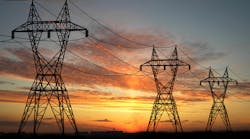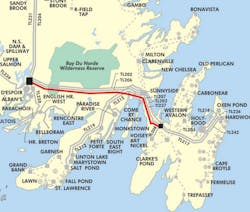Two of the largest transmission projects currently under construction in North America are north of the border in Newfoundland and Nova Scotia. The Emera and Labrador Holdings-sponsored Maritime Link project and Nalcor’s Bay d’Espoir to Avalon project are part of a larger strategy sponsored by Emera and Nalcor called the Labrador Island Transmission Link (LITL). The strategy is to move renewable energy from Newfoundland/Labrador to Nova Scotia and beyond. The long-haul project involves over 684 miles of transmission with a carrying capacity of 900 MW. The LITL is expected online in late 2019, at an estimated cost of $2.7 billion.
The Maritime Link segment is estimated to cost $1.5 billion when complete and involve approximately 320 miles of 200-kV high voltage direct current (HVDC) transmission running from Granite Canal, Newfoundland to Cape Breton, Nova Scotia. The project includes 112 miles of undersea cable connecting the two provinces. Construction started in mid-2015 and is expected online later this year.
The Bay d’Espoir to Avalon segment involves approximately 117 miles of 230kV line at an estimated cost of $292 million. The line clearing process and initial construction started late last summer and is expected to be complete in October of this year. The project will provide additional capacity into the Avalon Peninsula improving reliability and reinforcing the future interconnection of the island system with Labrador.
230-kV Line from Bay D’Espoir to Western Avalon
Both projects suffered a setback in construction in late June when the Newfoundland Occupational Health and Safety (OHS) division ordered Nalcor and Emera to inspect installation of new towers after the death of three workers this year. Two of those workers died on the Bay d’Espoir project in mid-June when towers they were working on collapsed. One death occurred back in January on the Maritime Link project and recently a tower collapse occurred in June without injury. Construction at both projects is on hold until the OHS review is complete.
Projects in the news
On July 6, the Missouri Public Service Commission staff once again advised the Commission to not support Clean Line Energy Partner’s Grain Belt Express transmission project. The commission will be hearing oral arguments on the case scheduled for Aug. 3 in Jefferson City. This marks the third time Clean Line Energy has attempted to gain a Certificate of Convenience and Necessity (CCN) to build the 780-mile project from Spearville, Kansas, to Sullivan, Indiana.
Clean Line has gained approval in every state except Missouri. The HVDC project is estimated to cost $2.3 billion. With Commission approval, construction could start in 2018, with completion in 2021. The Commission staff cited the inability of Clean Line to gain approval from local governments along the path as the primary reason to deny their application.
The case is like a recent case in which the Missouri Supreme Court refused to hear Ameren Transmission Co. of Illinois’s appeal to gain approval of their Mark Twain Transmission Project. Like Clean Line, Ameren was also denied based on their failure to gain local support. Attorneys for Clean Line claim that the cases are not similar because Grain Belt should be treated as a ‘line’ CCN and Mark Twain was treated as an ‘area’ CCN. There are two separate approaches written into the statutes for those categories.
On June 26, Fortis Corp.’s subsidiary ITC Holdings, the largest independent electric transmission company in the United States. received approval through the issuance of a Certificate of Public Convenience and Necessity from Canada’s National Energy Board to proceed with their ambitious Lake Erie Connector Project.
The project involves a 1,000 MW bi-directional, HVDC underwater transmission line that will connect the province of Ontario with Pennsylvania. In late May, the Lake Erie Connector gained two required permits for the project from the Pennsylvania Department of Environmental Protection and has received the necessary Presidential Permit from the Department of Energy – a required approval for all international border projects.
The Lake Erie Connector involves 73 miles of underwater +/- 320-kV line with converter stations located in Erie, Pennsylvania, and Nanticoke, Ontario. Along with the underwater segment, the project includes short distance underground construction connecting the cable to the converter stations. The project is estimated to cost nearly $1 billion and if everything goes to plan, will be completed in 2019.
Basin Electric Cooperative’s Antelope Valley Station to Neset Transmission Project in North Dakota is expected to be completed later this year. The 200-mile project includes new and modified substations and spans six western North Dakota counties. The project is estimated to cost $350M when complete.
New projects announced
On June 12, Xcel Energy and ITC Midwest announced they would be holding public open houses in mid-July to discuss their plans to build a 345kV transmission line from Xcel’s Wilmarth substation north of Mankato to ITC Midwest’s Huntley substation, south of Winnebago.
The project involves 40 miles of construction at an estimated cost of $80 million. If the project is approved by the Minnesota Public Utilities Commission, construction will start in 2020 with an online date in 2021.
In mid-June, ERCOT’s board of directors endorsed the $336 million Far West Texas Transmission Project involving two new 345 kV lines developed and owned by Oncor, American Electric Power Service Corporation and the Lower Colorado River Authority Transmission Services Corporation. ERCOT cited tremendous load growth in west Texas driven by increased oil and natural gas exploration as the driver behind the project. Between 2010 and 2016 average annual load growth was near 8%.
The first segment involves a new 101-mile circuit crossing four west Texas counties connecting the Odessa and Riverton substations. The second segment extends 68 miles in Pecos county connecting the Bakersfield and Solstice substations. Once approved by the Public Utility Commission, the project is expected to take four to five years to be completed.
Two major projects were recently announced with online dates in late 2020. Transource Energy’s Independence Energy Connection involves 40 miles of 230-kV line spanning across counties in Pennsylvania and Maryland. The projected cost is estimated at $320M. Rocky Mountain Power’s Aeolus to Bridger/Anticline project involves 140 miles of 500-kV construction and is estimated to cost $300 million. The project is part of the 1,000 mile, $3.68bn Gateway West Project running from the Windstar substation in central Wyoming to the Hemingway substation in western Idaho.
International projects in the news
Korean-based LS Cable will provide underwater replacement cable for the 0.93-mile link between Singapore’s new town of Woodlands and Malaysia’s southern resort town of Johor Bahru. The Singapore Electric project involves the replacement of 30-year-old cable that has been failing. This is the first case in which a South Korean company has exported high voltage submarine cable to a Southeast Asian country. The project is estimated to cost $55M.
French cable company Nexan has been awarded the contract to provide transmission operator TenneT undersea cable for the DolWin6 German offshore wind project. The contract involves two 56-mile segments of 320-kV HVDC cables with a contract value of $117M. Along with the cables, Nexan will be installing a fiber-optic cable. The project is expected to be operational in 2023. On July 17, TenneT awarded Siemen’s with the contract to provide the sophisticated converter station technology needed for the DolWin6 900 MW wind project.
The Vadodara, India based Gujarat Energy Transmission Corp. Ltd. (GETCO) has plans to invest $1.7bn to build 400 new substations and add over 6,200 miles of transmission by 2021-22. The ambitious project involves construction of 80 substations per year and over 1,240 miles of transmission per year over a five-year period.



